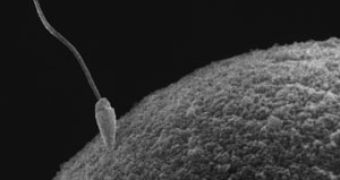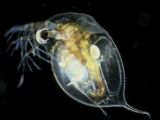A colleague has already written about the biology of love. So it seems that I'm left with sex. Tudor wrote: "love is just a clever way to trick the human individuals into multiplying". It's hard to tell how serious he was about this, but if we're at it a question pops up: After all, why are we multiplying? Or more precisely, why is sex a necessary part of the story? Why don't we multiply like bacteria, dividing ourselves?
Amazing as it might be, this is actually a legitimate biological question that continues to puzzle scientists. "It is known that sex is common in plants and animals, and that asexual species are typically short-lived, but why this should hold throughout evolutionary time is a great mystery," said Susanne Paland, an evolutionary biologist at Indiana University Bloomington.
At the first glance, sexual reproduction shouldn't spread throughout the gene pool: During sexual reproduction only half of the parents' genes are transmitted to its offspring, while during asexual reproduction virtually all the genes are copied (apart from a few errors). Thus, the gene for sexual reproduction shouldn't be able to overcome the one for asexual reproduction. This dilemma is known as "the cost of males" - why should females use males for reproduction instead of just cloning themselves?
But in most branches of the tree of life, asexual creatures gradually changed into sexual ones. The intermediary stages included some beings capable of both types of reproduction that eventually lost the ability to reproduce asexually. So, it seems that sexual reproduction comes with some definite advantages which are so great that they overcome the fact that parents transmit only half of their genomes to their offspring. The question is what are these advantages?
These advantages are so great that the return to asexual behavior is rare. In case of mammals it's virtually impossible to happen, due to a phenomenon called genomic imprinting - a small number of genes are expressed from a maternally inherited chromosome and silenced on the paternal chromosome, while other imprinted genes display the opposite expression pattern. This phenomenon also creates difficulties for cloning mammals. Other animals such as reptiles, fish and insects, have occasionally reverted to asexual reproduction but the asexual populations tend to be relatively short lived in an evolutionary time scale.
"Asexuality seems to be an evolutionary dead end," said Ricardo Azevedo, an assistant professor in the department of biology and biochemistry at University of Houston. "So sex must have its benefits."
Many benefits of sex have been proposed over the last century, but scientists have had a hard time figuring out which ones are decisive. One of the most prominent theories is that sexual reproduction decreases the number of harmful genes. In the absence of sexual reproduction, deleterious genes manage to ride along the good ones more easily. According to this theory, sex is useful because it shuffles the genome, "unlinking" genes.
Empirical evidences
Susanne Paland and her colleagues used the model species Daphnia pulex, or water flea, to test this idea. The results were published in Science. They have discovered that, besides the fact that sex reorders genes and efficiently removes deleterious gene mutations, sexual reproduction maintains its own existence by punishing, in a sense, individuals of a species that meander into asexuality.
"Our results show that asexual deviants are burdened by an ever-increasing number of genetic changes that negatively affect the function of their proteins," she said. "It appears sex is important because it rids genomes of harmful mutations."
The scientists used mitochondrial genome data to compose a phylogenetic tree depicting relationships among sexual and asexual strains of Daphnia pulex sampled from 75 ponds as far west as Illinois and as far east as Nova Scotia, Canada. The mitochondrial genome is a type of DNA residing outside the nucleus. Because it's inherited maternally, it can be used to trace the family tree. This tree revealed that sexual populations had recently and repeatedly spun off asexual strains.
After sequencing the entire mitochondrial genomes (i.e. discovering what proteins are coded by the mitochondrial genes) the scientists compared the rates of protein evolution of sexual and asexual lines of Daphnia pulex. They found that the asexual lines accumulated bad mutations four times faster than the sexual lines.
Thus, it seems that sex is responsible for the removal of those defects. Thus, although the ability to reproduce asexually may be useful to individual organisms that can't get mates, its long-term benefits are questionable. And what counts for the genes is the long term.
"Ultimately, we would like to know how long a species can abstain from sex without going extinct," coauthor Michael Lynch said.
A mathematical model
Ricardo Azevedo, collaborating with Christina Burch from the University of North Carolina at Chapel Hill, has devised a mathematical model that tries to get behind the scene and to uncover why exactly sex is capable of cleaning up the genome from bad mutations. Their study was published by Nature. The model also makes some predictions that are not entirely comforting.
The point of such mathematical models is to determine which factors can really overcome the "cost of males". Qualitative arguments cannot get you there. Azevedo, Burch and their team created a very simple model of how genes interact with each other to produce an organism and simulated the evolution of this simple genetic system under different conditions. They weren't expecting very much.
But, to their surprise, this simple model yielded the fact that sexual reproduction automatically produces a special feature known as negative epistasis which, in turn, confers an evolutionary advantage to sexually reproducing organisms. In other words, sexual reproduction may be self-reinforcing. Negative epistasis is the situation when the negative effects of various harmful mutations are additive (the harmful mutations don't hamper each other), thus making the organisms progressively worse off. Negative epistasis is so harmful that the cost of males is worth paying.
The scientists also found that the model was capable to successfully describe the fact that sexually reproducing populations evolve an increased robustness to mutations when compared to asexual ones. Thus, this model describes, more or less approximately, the situation tested empirically by Lynch and Paland.
The bad news that comes from this study is that our organisms' robustness to mutations also makes us vulnerable on the long term to the dangers posed by bacteria and viruses. These primitive organisms have high mutation rates, thus producing newer versions of themselves very rapidly, and our organisms might not be fit to counter them for a very long time. There is some hope however as our immune system has some adaptations designed precisely to deal with the high mutability of bacteria and viruses. (Read article.) Moreover, medical science may be another important "adaptation" as the latest extension of our immune systems.
Sex is the genes' way of worrying about their future
Sexual reproduction is biologically costly and can be quite complicated. In case of many animals, from fish to mammals, sex is preceded by intricate mating behaviors. It requires the compatibility of sexual structures, an insertion event, fertile eggs and sperm, and the successful unification of egg and sperm into a viable zygote. All of this adds up to a big energy investment - energy an organism might have used for other purposes. So what justifies this big energy investment?
The mathematical models can offer a solution to this question and still leave us puzzled. What are these models really saying? What is the bottom line beneath the formulas and the algorithms?
I think that the bottom line is this: in case of asexual beings, the genes just give the recipe for the construction of the creature, and then natural selection comes to play - the organism may or may not be successful in the competition for the scarce resources and manage to survive and reproduce. The genes just take their chances with the blind natural selection.
However, in case of sexual beings, the individual (in most cases the females) choose they mates. (Or, in case of plants, insects such as bees uncounsciously choose the mates.) They don't mate at random with anybody. The mating behavior of the males tries to show the females that they are worthy of being fathers - in other words they are trying to show that the genes they are carrying are a good investment, the offspring will be fortunate to have them and implicitly that half of the female's genome that happens to get passed to the offspring will enjoy the company of the male's genes.
But why does a particular female feel attraction toward a certain male rather than toward another one? The point is that the female's sexual behavior is itself the product of her genes. Thus, the female's genes "take care" that they will be incorporated in the future in an offspring with maximum chances of being a successful individual (that survives and reproduces further). Sex is thus, the genes' way of worrying about their future. The genes of asexual creatures are incapable of doing this.

 14 DAY TRIAL //
14 DAY TRIAL // 
